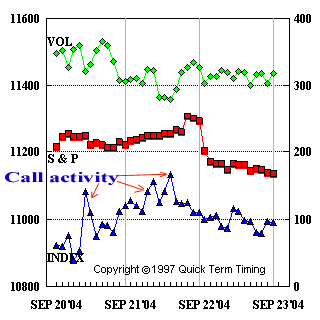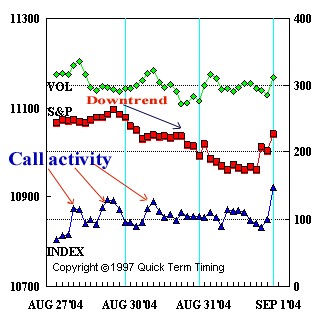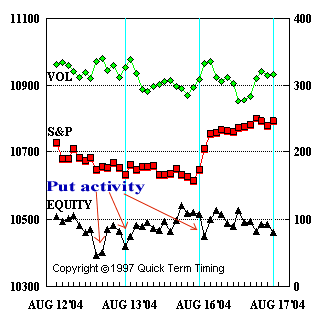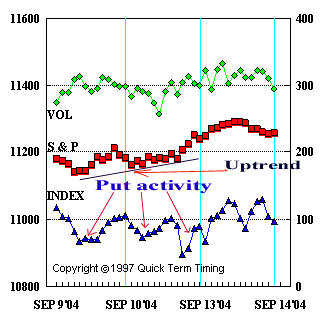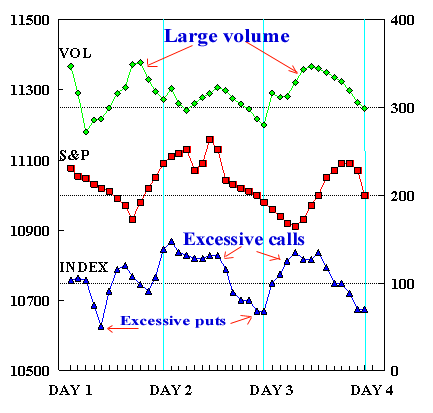The S & P emini was first introduced in Sep 1997 and has grown to be one the most actively traded futures markets. Underlying the S & P emini is a market so huge that it can't be manipulated or controlled. The S & P 500 has a market value in the $TRILLIONS.
Some of the features of the emini markets include:
No insider trading
No manipulation
No corruption
No scandals
Consistent volatility
Unmatched liquidity
Huge leverage
Tight spreads
Little slippage
100% electronic order execution
Low commissions
No uptick rule
Go short as easy as long
Hedging opportunities
Favorable tax advantages
The eminis are truly a traders dream.
Emini’s are also available on the Nasdaq 100 and the Dow 30 Industrials
In this three part series, I will show you how to use a few indicators and some simple methods to get the odds in your favor when trading the Emini's. Many of these indicators tend to lead the movement in the futures rather than follow.
In the first article I will introduce you to an indicator I first devised in the 1980's when options on the stock indexes first started trading. I have changed the structure of this indicator over the years and will make ongoing changes to reflect the then current market.
I measure the current sentiment of traders in the market by tracking the trading in puts and calls at the CBOE. (Chicago Board of Options Exchange) A large volume in calls versus puts indicates the sentiment is bullish and a large volume of puts versus calls indicates that the market sentiment is bearish. When the majority of investors are bullish, a top is reached (If most are really bullish, they've already bought their stock - who's left to buy from them?) Conversely, if the majority is bearish, that's the bottom because most investors have already done their selling. It's a contrarian view of the market - when most people are bullish the averages should go down; when most are bearish, they should rise. This is a theory that I maintain is equally valid for the short term(days) and the quick-term(hours) as it is for the long-term(years) and intermediate -term(months).
The records of numerous advisory services and brokerage firms confirms the validity of the sentiment theory on the longer term. When the majority of market participants are bearish, the bottom of the market is near and vice – versa, when the majority is bullish a market top may be at hand. These longer term measures of sentiment are difficult to use in timing the shorter term direction of the market. Given that, I wanted to devise an indicator that would aid me in trading the eminis intra-day.
The activity in the options market is available to everyone and is updated every ½ hour from the CBOE. Reports from various media sources look like this:
Index Calls 150,382
Index Puts 238,425
Equity Calls 867,425
Equity Puts 522,832
It’s interesting information, but what does it mean? Is that a lot of calls? Is that a lot of puts?
The answer is: IT DEPENDS ON WHEN IT HAPPENS. The “normal” put-call ratio changes over time. The normal put-call ratio and volume varies not only intra-day but also varies each day in the monthly option cycle. The trick is to compare the current put-call ratio and volume to the normal put-call ratio and volume for the current time period.
To measure the current sentiment, I now construct two separate oscillators, which are updated every ½ hour during the market trading day. I call these my market sentiment barometers. The index barometer measures the option activity in the index options and the equity barometer measures activity in equity options. Both barometers compare the current readings with the expected “normal “ activity. On the graphs that follow the "normal" put call activity would fall on the 100 line. If there is more put activity than "normal" the barometer is below the 100 line(bullish) – if there is more call activity than "normal" the barometer is above the 100 line(bearish).
The market sentiment barometers tend to lead the subsequent market activity. The index sentiment barometer usually leads the market by 1-3 hours and the equity barometer leads by 3-6 hours. For example, when there is excessive put activity in the index options, expect the market to rally over the next 1 to 3 hours. Or if there is excessive call activity in the equity options, expect the market to top out over the next 3 to 6 hours.
The best signals are given when both barometers see excessive call activity (at market tops) or both barometers indicate excessive put activity (at market bottoms). Great signals also occur when the market and the market sentiment barometers diverge. If the market is in an up-trend (higher lows and higher highs) and put activity increases – this means the rally should continue. Or if the market is in a down-trend (lower highs and lower lows) and call activity increases – the decline will most likely continue.
These market sentiment barometers are available at my website www.qtt.com You will also find a tutorial on the barometers and more examples of actual market activity. A copy of this article can be found at www.emini.tv.
The second in this series of indicators to trade the eminis will feature two indicators that also tend to lead the movement in the emini markets. Check the next Quarterly issue of Trader’s World.
Here are some sample charts of the sentiment barometers:
